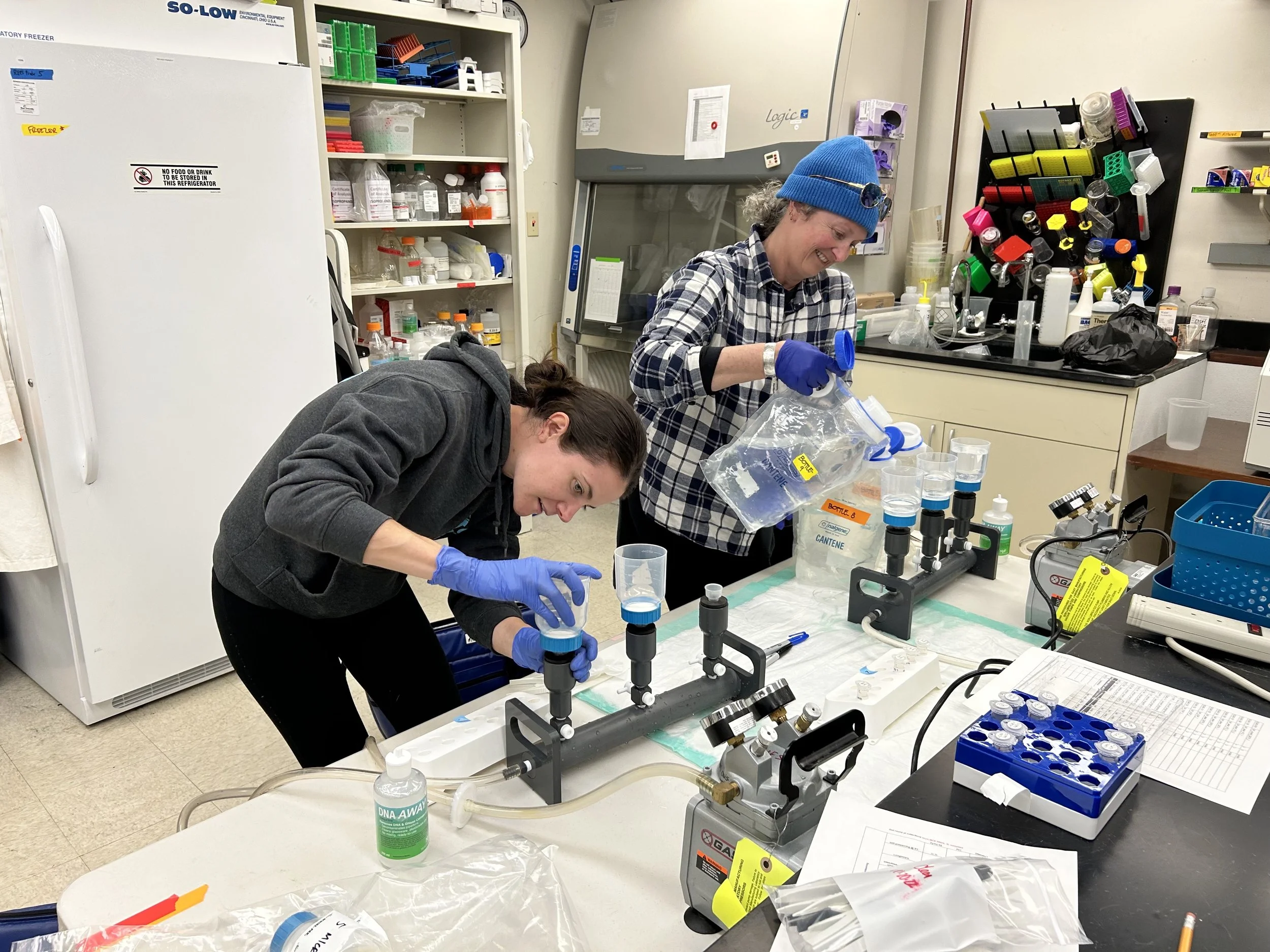MMARINeDNA
Marine Mammal Remote detection via INnovative environmental DNA sampling
MMARINeDNA: Marine Mammal Remote detection via INnovative environmental DNA sampling is a project funded by the US Navy to investigate and advance eDNA science. We aim to understand the transport, persistence, and distribution of eDNA in marine environments from marine mammal targets on multiple spatial, vertical, and temporal scales.
Our major objectives are threefold. First, to understand the fate and transport of eDNA and thereby interpret eDNA detections from marine mammals in a spatially and temporally explicit context. Second, to evaluate eDNA as a complement to, or plausibly, as an alternative to, traditional visual observations and acoustics detections for cetaceans. Thirdly, to apply the lessons learned to map marine mammals along the US west coast using eDNA.
Module 1 links oceanographic modeling with systematic field observations to produce a detailed view of the behavior of DNA at scales of tens to hundreds of square kilometers. This module aims to address three questions. First, how do molecular detections vary in space and time, given a known point source? Second, can we model the fate and transport of eDNA molecules for a target species and estimate the time since deposition? And third, can we hindcast the most probable time and place of a point source, given quantitative eDNA detections?
Module 2 joins eDNA data from ongoing research cruises with acoustic and visual mammal sightings on larger-scale transects, complementing these with time-series analysis of eDNA from archival samples. This module is designed to address three questions. First, how are marine-mammal detections via eDNA distributed in time and space? Second, How can we best integrate eDNA detections with contemporaneous visual and passive acoustic observations? And third, Can we reconstruct historical cetacean and prey fields via archival molecular analysis?
Module 3 uses water samples from an ongoing west-coast-wide NOAA survey to create a 3D map of the abundance of marine mammal eDNA. The three modules share common analytical techniques and accordingly will reinforce one another as they proceed.This module is designed to address three questions. First, what is the 3D distribution of eDNA from marine mammals along the US West Coast? Second, What prey/target species co-occur with marine mammals in the California Large Marine Ecosystem? And third, are there consistent hotspots of marine mammal DNA & do they corroborate existing hotspot knowledge?
With our partners at NOAA, UCSD, University of St. Andrews and CalCOFI, the project will theoretically and experimentally characterize eDNA in the marine environment and parametrize models supporting the ability to hindcast source locations using eDNA detections throughout the water column.
This research is supported by the Office of Naval Research under Award Number (N00014-22-1-2719)
Publications
Brandão-Dias, P.F., Shaffer, M., Guri, G. et al. (2025). Differential decay of multiple environmental nucleic acid components. Sci Rep 15, 26791
Shaffer, M.R., Andruszkiewicz Allan, E., Van Cise, A.M., Parsons, K.M., Shelton, A.O. and Kelly, R.P. (2025). Observation Bias in Metabarcoding. Mol Ecol Resour e14119.
Xiong, J., MacCready, P., Brasseale, E., Andruszkiewicz Allan, E, Ramón-Laca, A., Parsons, K. M., Shaffer, M., Kelly, R. P.(2025). Advective Transport Drives Environmental DNA Dispersal in an Estuary. Environmental Science & Technology, 59 (15), 7506-7516
Brasseale, E., Adams, N., Allan, E. A., Jacobson, E. K., Kelly, R. P., Liu, O. R., et al. (2025). Marine eDNA production and loss mechanisms. Journal of Geophysical Research: Oceans, 130, e2024JC021643.
Xiong, J. and MacCready, P. (2024). Intercomparisons of Tracker v1.1 and four other ocean particle-tracking software packages in the Regional Ocean Modeling System, Geosci. Model Dev., 17, 3341–3356, https://doi.org/10.5194/gmd-17-3341-2024.








![P1010386[1].JPG](https://images.squarespace-cdn.com/content/v1/519bcfc0e4b0de2d4d90356d/1753901058720-GK78R7D77AYEJ6CZBNJM/P1010386%5B1%5D.JPG)













